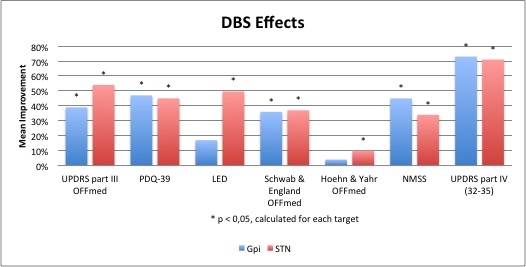Session Information
Date: Thursday, June 23, 2016
Session Title: Parkinson's disease: Clinical trials, pharmacology and treatment
Session Time: 12:00pm-1:30pm
Location: Exhibit Hall located in Hall B, Level 2
Objective: To evaluate the effects of Deep Brain Stimulation(DBS) on non motor symptoms(NMS) in Parkinson’s disease(PD) and compare the efficacy of pallidal(GPi) versus subthalamic(STN) stimulation.
Background: DBS is a established treatment for motor symptoms of PD, two targets are preferably used, GPi and STN. Although both of them significantly improve motor symptoms, their effects on NMS are still not well known. Considering that they tend to have their particularities, there might be a more suitable patient for each target. We present preliminary data of an ongoing study.
Methods: We designed a prospective, randomized, blind study. Patients with idiopathic PD and formal indication of treatment with DBS were enrolled. Dementia was excluded by neuropsychological assessment. They were randomly divided into two groups, one of GPi stimulation and another of STN stimulation. The evaluations occurred preoperatively and 6 months after DBS implantation and were performed on OFF med, ON med and OFF med/ON stim. Besides clinical interview, we applied UPDRS, Hoehn&Yahr, Schwab&England, Non Motor Symptoms Scale(NMSS) and Questionnaire for Impulsive-Compulsive Disorders in Parkinson’s disease(QUIP-S). For statistical analysis we used the t-test, paired t-test, Mann-Whitney and Wilcoxon.
Results: 16 male and 10 female were included for analysis. The mean age was 51,5±8,1 years, with 11,8±3,9 years of disease. The mean Hoehn&Yahr OFFmed preoperative was 2,8±0,8. Except for gender, there were no basal differences between the groups.
| GPi (Mean±SD) | STN (Mean±SD) | p value | |
| Age | 52±7,0 | 51,1±8,9 | 0,78 |
| Gender | 5 male, 8 female | 11 male, 2 female | 0,018* |
| Age of onset of PD (years) | 40±8,4 | 39,6±7,9 | 0,91 |
| Duration of disease | 12,2±3,3 | 11,5±4,3 | 0,67 |
| LED | 1332,6±499,5 | 1298,2±348 | 0,58 |
| Pramipexol dose | 1,5±1,5 | 1,8±1,6 | 0,62 |
| UPDRS I | 3,8±2,0 | 3,6±2,2 | 0,79 |
| UPDRS II OFFmed | 24,7±3,6 | 26,2±5,6 | 0,46 |
| UPDRS III OFFmed | 41,8±7,2 | 44,2±6,8 | 0,36 |
| UPDRS III – Axial OFFmed | 7,8±3,6 | 8,5±4,2 | 0,57 |
| UPDRS III ONmed | 11,4±6,4 | 13,2±6,3 | 0,38 |
| UPDRS III – Axial ONmed | 1,9±0,8 | 2,4±1,9 | 0,94 |
| UPDRS IV (32-35) | 3,7±2,7 | 3,2±3,0 | 0,61 |
| Schwab & England OFFmed | 61,5±11,2 | 363,1±10,7 | 0,96 |
| Hoehn & Yahr OFFmed | 2,7±0,5 | 2,9±1,0 | 0,89 |
| QUIP-S | 1,8±2,2 | 0,3±0,6 | 0,12 |
| NMSS | 71,4±23,4 | 67,8±49,1 | 0,27 |
| PDQ-39 | 54,3±9,9 | 48,8±11,3 | 0,22 |
 There was significant improvement of NMSS score (GPi p=0,001; STN p=0,019) and mood/cognition NMSS domain (GPi p=0,002; STN p=0,03) on both groups; sleep/fatigue (p=0,002) also improved on GPi, urinary (p=0,03) and miscellaneous (p=0,04) on STN group. UPDRS part I (p=0,008) and QUIP-S (p=0,03) significantly improved on GPi stimulation. The comparison between the groups showed that the STN induced a greater reduction of LED (p=0,018) and pramipexol dose (p=0,04) and improvement of total (p=0,033) and axial UPDRS part III (p=0,026). The GPi DBS, in turn, led to a greater reduction of UPDRS part I (p=0,015).
There was significant improvement of NMSS score (GPi p=0,001; STN p=0,019) and mood/cognition NMSS domain (GPi p=0,002; STN p=0,03) on both groups; sleep/fatigue (p=0,002) also improved on GPi, urinary (p=0,03) and miscellaneous (p=0,04) on STN group. UPDRS part I (p=0,008) and QUIP-S (p=0,03) significantly improved on GPi stimulation. The comparison between the groups showed that the STN induced a greater reduction of LED (p=0,018) and pramipexol dose (p=0,04) and improvement of total (p=0,033) and axial UPDRS part III (p=0,026). The GPi DBS, in turn, led to a greater reduction of UPDRS part I (p=0,015).
| Mean change at 06 months from baseline | |||
| GPi (Mean±SD) | STN (Mean±SD) | p value | |
| LED | 287,2±486,1 | 669,3±471,0 | 0,018* |
| UPDRS part I | 1,8±1,9 | 1,1±3,0 | 0,015* |
| UPDRS part II OFFmed | 11,9±6,9 | 15,2±3,9 | 0,14 |
| UPDRS part III OFFmed | 16,4±8,2 | 23,6±7,0 | 0,033* |
| UPDRS part III OFFmed – Axial | 3,2±3,6 | 5,1±2,4 | 0,026* |
| UPDRS part IV | 2,6±2,5 | 2,3±3,2 | 0,532 |
| Schwab & England OFFmed | 16,9±15,4 | 21,5±10,3 | 0,219 |
| Hoehn & Yahr OFFmed | 0,2±0,4 | 0,4±0,7 | 0,335 |
| NMSS total score | 35,5±23,3 | 32,3±47,4 | 0,837 |
| PDQ-39 | 26±14,3 | 22,6±14,1 | 0,797 |
| QUIP-S | 1,5±2,0 | 0,3±0,8 | 0,08 |
Conclusions: DBS can also be used for the treatment of NMS, its effects on each symptom should be studied in detail. Both GPi and STN are effective, but GPi stimulation tends to be better for behavioral while STN stimulation tends to be better for motor symptoms.
To cite this abstract in AMA style:
M.G. dos Santos Ghilardi, R.G. Cury, R.C.R. Martinez, M.J. Teixeira, E.R. Barbosa, E.T. Fonoff. Pallidal versus subthalamic stimulation for PD: Beyond the motor effects [abstract]. Mov Disord. 2016; 31 (suppl 2). https://www.mdsabstracts.org/abstract/pallidal-versus-subthalamic-stimulation-for-pd-beyond-the-motor-effects/. Accessed December 25, 2025.« Back to 2016 International Congress
MDS Abstracts - https://www.mdsabstracts.org/abstract/pallidal-versus-subthalamic-stimulation-for-pd-beyond-the-motor-effects/
